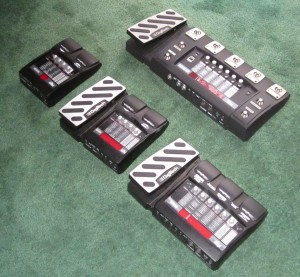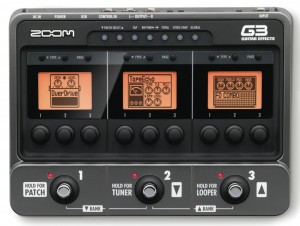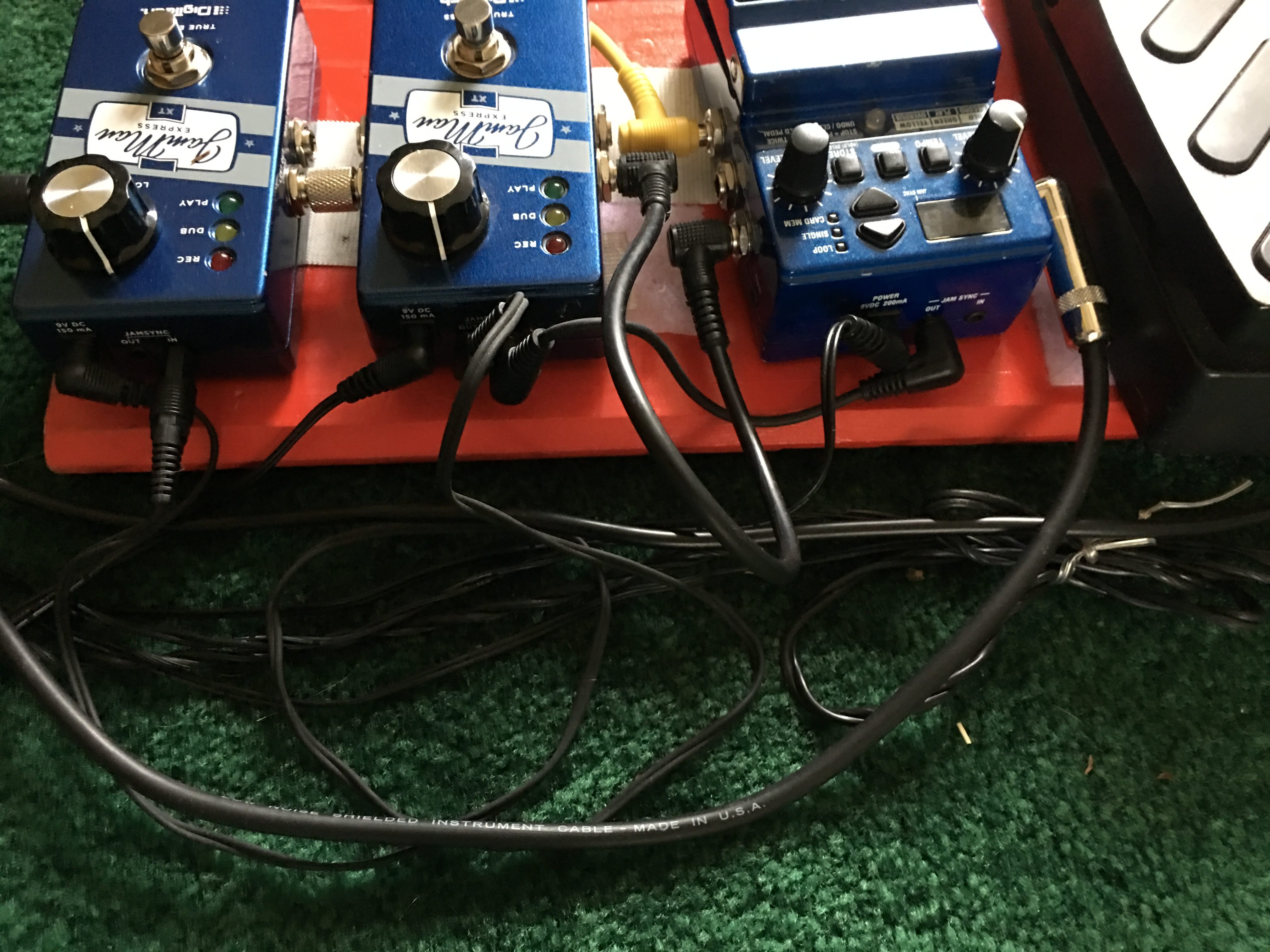
Comparing the Zoom G3 to the Digitech RP
As I work on patches for the Zoom G3 (now in version 2; see our Zoom G3 page), I’m constantly comparing what I hear to the sounds I get from my Digitech RP355. In fact, I have the two boxes side by side on the floor with an A/B pedal connecting them. Here are a few of the things I’ve learned from direct comparisons.
Don’t Replace Your RP
I like to start with the bottom line, so here it is: if you’re running an RP with one of my patch sets in it, I do NOT recommend that you run out and replace it with a Zoom G3 (unless you need something that runs on batteries, which the RP doesn’t). What the Zoom does isn’t new and different (or better) enough to justify starting over. Further, if your budget is strictly limited, you get more for your money from the Digitech line. The starting price point for a G3 (new) is about $160-170; for an RP, it’s under $100, and that $100 buys you a smaller set of the same amp models and FX you find in the higher-end RPs. In fact, I’d go so far as to say that in the $200-and under price range, and ESPECIALLY in the $150-and-under range, the Digitech RPs are absolutely the best value for money right now. (But I may change my mind as I get closer to the G3.)
Amp Models: Thumbs Up x2
Both the Zoom and the Digitech RPs make some interesting sounds. Both do basic amped-up sounds well, and applying the lessons I learned in programming the RPs has made it possible for me to move quickly where programming amps on the Zoom is concerned. The G3 has four Fender amp and cabinet models, and that’s where I started. All of them work with harp, some more to my taste than others. In my opinion the modulation FX in the Digitech RPs (detune, flange, chorus, pitch shifting, vibrato, tremolo, etc.), especially the pitch-based ones, sound better (meaning bigger and clearer) than the ones in the Zoom–and the G3 doesn’t have ANY rotary speaker effect! (The vibrato is nice, but a rotary effect is REALLY nice.)
Zoom Gets Points on Performance Flexibility
The Zoom gets big points for letting you load the FX in any order you like and turn them off and on with dedicated footswitches. That’s a cool way to make and modify super-freaky tones (though most of my customers don’t use a lot of super-freaky tones). In performance it’s great for making deep, rapid changes in tones on a single patch, which is useful when you’re looping, for example.
One substantial point in favor of the G3 is that it will run on batteries, which makes it a very useful device for all sorts of situations where setup time is short and/or wall power is unavailable. I think many players will find that a G3 represents better value for money than a Tech 21 Blonde pedal, which sells for about the same price but doesn’t include any FX other than amp modeling. Of course a Zoom will require a longer learning curve for the user than the Blonde will, but that’s the difference between a multi-FX box and a single effect.

Summary: 2 Nice Pieces o’Kit
I don’t hear a difference in the quality of the amped tones the Zoom produces compared to the Digitech RP–they both sound very good, which is what you’d expect for 4th-generation chip-driven products. There are things you can do with a G3 that you can’t do with a Digitech. The reverse is also true: you don’t get a rotary speaker effect with a Zoom at less than $300, and the reverbs in even the least expensive RPs just slay the Zoom’s. I suspect that most users who want a handful of good basic sounds with (at most) reverb and delay would find that their choice would depend more on the feel of playing the device than anything else, because that’s where the biggest differences between the Zoom and the RPs lie. For players who push the devices to their limits, there’s likely to be one or two FX in one or the other box that makes the difference. The first time I played through an RP’s pitch shifter, I picked the thing right off the floor and took it to the checkout counter. I haven’t had that experience with the Zoom yet, but I haven’t had time to run through everything in it either.
That said, I like the G3’s basic sound and battery-based operation, and I like giving customers a choice, so I’m working on patches. Stay tuned.
Tags In
Related Posts
5 Comments
Leave a Reply
You must be logged in to post a comment.
WHAT’S NEW
Categories
- Audio/Video
- Blog
- Blue Future
- Digitech RP Tricks and Tips
- Discography, CDs, Projects, Info, Notes
- Featured Video
- For the Beginner
- Gallery
- Hunter's Effects
- Hunter's Music
- Huntersounds for Fender Mustang
- Meet the Pros
- More Video
- MPH: Maw/Preston/Hunter
- My Three Big Contributions
- Player's Resources
- Pro Tips & Techniques
- Recommended Artists & Recordings
- Recommended Gear
- Recorded Performances
- Reviews, Interviews, Testimonials
- The Lucky One
- Uncategorized
- Upcoming Performances
- Zoom G3 Tips and Tricks


I’m looking at Zoom MS-50G
It looks like a best solution for jam. Batteries operated, noise gate (to kill feedback, not available for battery powered Line6), delay, amp models, very small. Also usefull for big pedalboard to use for one-song FX. Not the best possible tone. Unfortunately no mic pre and no XLR input (the same problems for all multiFX except Line POD X3 and HD and TC-helicons)
I gotta say,
having owned two digitech and six zoom products , they’re both unique, Digitech frustrate me to the point where i said never again, I LOVE their LIMITED, unique exclusive sounds ie YaYa is one of the best sounds ive ever came across, not everyones cup of tea , but for me is simply outa this planet , and inspired me to use it for a new track
sadly the RP200 went haywire ,very unstable , uncontrolable and in the in end , totally UNUSEABLE .
Zoom products on the other hand crept into my equipment list , proved their reliabilty (well they WERE made in JAPAN , and we’ve all come to expect that from that corner of the globe )
sucessfully, if not spectacularily at first ,to become now my FX DEFAULT gear for guitars, bass, even my Mandolin goes through a Zoom G3X now,
Yes it lacks some sounds that i wish were there ,
but what price due you put on reliablity eh?
Zoom Zoom !
AA Glasgow UK
@Andy: thanks for the testimonial. The RP200 went out of production maybe 15 years ago, not surprising that a sample of the type may go haywire every now and then. I’ve had very few problems with my RPs (and my 200 is still working…).
Mr. Hunter,
Your articles are very informative and have been more helpful than any other review/comparison I have read regarding the RP500 and the G3. Do you still feel that the RP500 is a better value than the G3 (I am looking at the G3XP)? Also, besides certain effects and amp models, is there anything the RP500 can do that the G3XP cannot?
Thank you,
Phil
@ Phil: Thanks for the compliment. When we say “better,” the question is “better for what.” i think both units have good amp modeling and delays, the basic stuff. I have made basic amped-up Bassman sounds on the G3 that are identical to my ear to their equivalents on the RP500. There are certain amp models on each unit that I like, but basically they’re both good in that regard. The RP500 has MUCH better reverbs than the Zoom. The RP500 has a rotary speaker effect, and the Zoom doesn’t. The RP500 has better pitch-shifting, but not as much of it as the G3, where you can stick up to six pitch shifters in a row (if you don’t use any other effect). The RPP00 has the Whammy, a dynamic pitch shifter, and there’s nothing like it on the Zoom. The Zoom has the ability to stack up to six FX, including amp modeling/EQ/delay/reverb/whatever, in any order you like, so you can make some pretty big sounds with it. The Zoom runs on batteries, which the RP will not.
I prefer the RP500 when wall power is available so I can use all those footswitches to modify my sounds. I’ve set up all my sounds for my repertoire on the 500, so if I’m playing my own material it’s definitely the one I go to. I like the Zoom in combination with the RP, and I like it fine when I have to play on battery power.